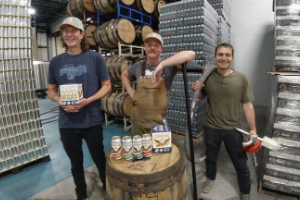237: Maker Tips for Growth and Keeping it Clean
Stormalong Cider scaled up their operations in 2017 when they moved from their cozy barn centered cidery to a shared production facility in Leominster in Massachusetts. We begin with considerations for growth of a cidery and then begin a dive deep into the production side of making cider with a specific focus on cleaning.
Featuring Stormalong owner, Shannon Edgar, Head Cidermaker Ben Roberts-Sano and Operation Manager Bright McConnell.

What is sanitary/cleanable what is clean in place?
Materials that touch cider must be made with a nonporous surface which is resistant to scratching and chemical degradation
These include stainless steel, glass, HDPE and PP plastics, silicone and other food grade rubber, teflon, specially prepared concrete or enamel coated steel vessels
What materials to avoid?
Metals like aluminum, brass, mild steel, copper, bronze, or chrome plated parts are NOT rated for food contact, and should not be used on any part of your system that touches product or co2. Copper is toxic and can easily absorb into cider on contact. Aluminum will corrode in caustic, and permanently stain steel parts in the same cleaning bucket.
Chrome parts will always chip.
Brass can leach lead (if not lead free) and copper into cider or common cleaning buckets
What is sanitary?
In order for a cleanable container or pipe part to be sanitary, it must have a smooth geometry, with no hidden or “dead spots” and must be easily disassembled for cleaning. a ball valve cannot be sanitary, because some of the surfaces of the ball are always hidden from the chemical action. threaded parts cannot be considered. pipes or vessels that contain areas that do not contact cleaning chemicals, or areas that cannot drain completely, cannot be considered sanitary, and cannot be properly cleaned without additional measures
Vessels like wooden barrels rely on temperature (steam/190 water) or food safe chemicals, like phosphate, ozone, citric acid, or sulfites and microbial communities in order to stay “clean” or at least repeatably infected.
Cleaning theory
The 4 factors of cleaning dirty vessels
- Time
- Temperature
- Mechanical action (how hard your spray, shake or scrub)
- Chemical concentration
In order to clean different materials, and different soils. For instance, a food grade plastic that is temperature sensitive and too soft to scrub, you could use 50% more chemicals and a significantly longer soak time to achieve the same result
Water won’t get quite as hot as you like?
- Turn the pump speed up, and run the clean for longer, perhaps add more chemicals.
- Even stainless steel can be worn by heavy cleaning over time, so make sure to clean enough. BUT there is such a thing as too much of a good thing!
Biofilms
- Bioflims can form when parts get dirty for too long. Normal cleaning procedures may not be effective, and the film may stay active for some time
- SO YOU MUST CLEAN DIRTY THINGS BEFORE THEY DRY (same day)
- A part with any visible soils cannot be considered clean, a part that is not clean cannot be sanitized, and any part that touches the floor or any other visibly unclean surface, must not pass go, and return directly to the dirty parts bucket
Mentions in this Chat
- Listen to Season 1 recording with Stormalong – 36 Shannon Edgar and Ben Roberts-Sano | Stormalong Cider, MA
Contact info for Stormalong
- Website https://www.stormalong.com/
Help Support Cider Chat Please donate today. Help keep the chat thriving!
Find this episode and all episodes at the page for Cider Chat’s podcasts.
- Listen also at iTunes, Google Play, Stitcher (for Android), iHeartRadio , Spotify and wherever you love to listen to podcasts.
- Follow on Cider Chat’s blog, social media and podcast
- Twitter @ciderchat
- Instagram: @ciderchatciderville
- Cider Chat FaceBook Page
- Cider Chat YouTube
Haven’t downloaded this episode yet? Here it is again for your listening pleasure.



